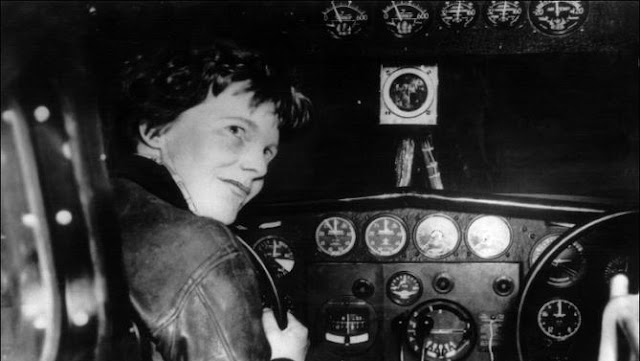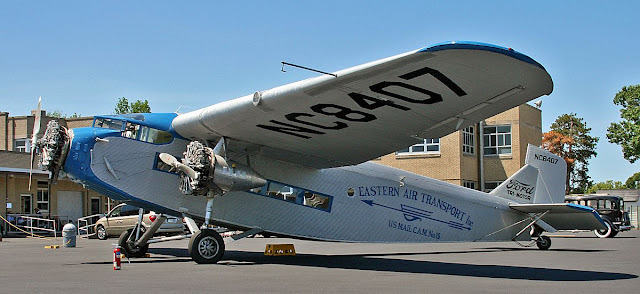XCV
The
Trimotor aircraft, in their various forms, represented the first truly
practical airliners the world had ever seen. Trimotors weren’t just a type of
plane, they represented a new generation in aircraft. Just as the Curtiss Jenny
had made aircraft seem familiar, the Trimotor made aircraft seem dependable.
The
first Trimotor wasn’t even a Trimotor --- it was a single engine monoplane with
an all-metal body slung beneath a laminated wooden wing covered with doped
fabric. The fuselage had a distinctively
elongated wedge shape, and it was covered with a corrugated skin.
 |
|
The
first single-engine Fokker F.VII "Trimotor"
|
Anthony
Fokker developed the single-engine Trimotor around 1923, basing it upon the
various Junkers designs he had encountered in Germany during World War I. Designated the F.VII, it had accommodations
for two crew and five passengers. Only five single-engine F.VIIs were built,
since Fokker soon came to realize that the plane had neither the power nor the
range to needed for carrying cost-effective payloads.
 |
|
A
Fokker F.VIIA with its distinctive three motor arrangement
|
Fokker
strengthened the wing and added two engines, giving the plane its eponymous
three motors. At the same time, he chose a larger, more efficient powerplant.
This increased both load and range. The F.VIIA of 1924 could carry eight passengers, and the
FVIIB of 1926 had greater range.
The
F.VIIB had a wingspan of 71’ 2” and a LOA of 47’ 11”. It could cruise at a
steady 100 miles per hour.
The
F.VII series was a remarkably successful type of airplane that set several
records. On May 9, 1926, Richard E. Byrd flew over the North Pole in a Fokker
F.VIIA, just days before days before Roald Amundsen accomplished the feat in
the airship Norge. Byrd did not
transit the Pole, but returned to Spitsbergen, while Amundsen landed in Alaska.
 |
|
The
Polar explorer, Admiral Richard E. Byrd, a Missouri Meerschaum smoker, overflew
the North Pole in a Fokker F.VIIB in 1927 and the South Pole in a Ford Trimotor
in 1929. Byrd was also an exponent of the Hollow Earth Theory of hidden
civilizations
|
In
June 1928, Sir Charles Kingsford Smith piloted an F.VIIB as the first aircraft to
cross the Pacific Ocean from the United States to Australia. He also crossed
the Tasman Sea from Australia to New Zealand.
On
June 17, 1928, Amelia Earhart became the first woman to fly across the Atlantic
as a passenger aboard a Fokker F.VIIB.
 |
|
Amelia
Earhart was the first woman to fly the Atlantic in the Fokker F.VIIB Friendship
|

By
the time Pan American was born in late 1927, the Fokker Trimotor had evolved
into the F.10 series, capable of carrying 12-16 passengers, and these planes
became Pan American’s first true airliners.
Not
to be outdone, Henry Ford began building his own Trimotors in 1926. They were
remarkably similar to the Fokker Trimotor, but they were the first all-metal
aircraft (no wood, no dope, no fabric) in the United States. Ford’s Trimotor was 50’ 3” LOA, with a
wingspan of 77’ 10.” They could carry sixteen passengers, two
pilots, and a steward.
Although
Fokker never sued Ford, Junkers did, and won, for patent infringements. Due to
this suit, the Ford Trimotor, affectionately known as the “Tin Goose,” never
flew in Europe.


On
November 27 and 28, 1929, Richard E. Byrd made the first flight above the South
Pole in a Ford Trimotor, just as he’d overflown the North Pole in a Fokker
Trimotor.
Franklin
Roosevelt flew aboard a Ford Trimotor during his 1932 Presidential campaign,
eschewing the traditional "whistle stop" train trip. FDR was not the
first man who was a President to go aloft, however; that honor belonged to his
cousin Theodore Roosevelt, who was a passenger aboard a Wright biplane in 1910.
FDR was the first President to fly while in office, and he flew Pan American.
A
Ford Trimotor was also used for the flight of Elm Farm Ollie, the first cow to
fly in an aircraft and to be milked in mid-flight. This stunt highlighted the
Trimotor’s strong role as a cargo carrier, a role some of the few surviving tin
geese still fulfill.




Of
the 199 Ford Trimotors built, 18 are still in existence, though only half of
those are still being used in day-to-day “working” roles. Hundreds of Fokker
Trimotors were built, either by Fokker directly, or under license. Scores of planes resembling the Fokker / Ford
models were built and flown throughout the world, making the Trimotor one of
the most successful airplane designs in history.
All
in all, virtually every airline functioning before the rise of the jet age used
one or the other or both types of Trimotors, or a variant.
Despite
this, the Trimotor had a relatively short half-life in the United States. The
reign of the Fokker Trimotor came on March 31, 1931, when the Fokker F.10
carrying the iconic Notre Dame football coach Knute Rockne crashed en route to
Los Angeles, California from St. Louis, Missouri. All on board were killed. It
was soon discovered that the wood-laminate wing had failed.

 |
|
The
lionized Notre Dame University football coach was mourned throughout the United
States. King Haakon of Norway (his birthplace) knighted him posthumously.
Rockne's death hit particularly hard in the Michiana region surrounding Notre
Dame
|

>>>
All Fokker Trimotors in U.S. airline service were temporarily grounded. Fokker
continued to build planes, but its reputation was marred.
>>> A schedule of regular, frequent
inspections of all commercial aircraft was instituted by the Federal
government.
>>>
All airline accident information, which had been classified, was henceforth to
be made public.
>>>
The Civil Aeronautics Board (CAB), an independent investigative organization, a
forerunner of the National Transportation Safety Board (NTSB), was created.
>>> Wooden aircraft were largely
retired from commercial service.
Although
the Ford Trimotor at first suffered from some guilt by association due to its
resemblance to the Fokker, as an all-metal aircraft it had a brief resurgence before
the Douglas DC-3 and the Boeing 247 land planes were developed.
Little
of this affected Pan American. By 1931, it had left its Fokkers and Fords far
behind.
No comments:
Post a Comment